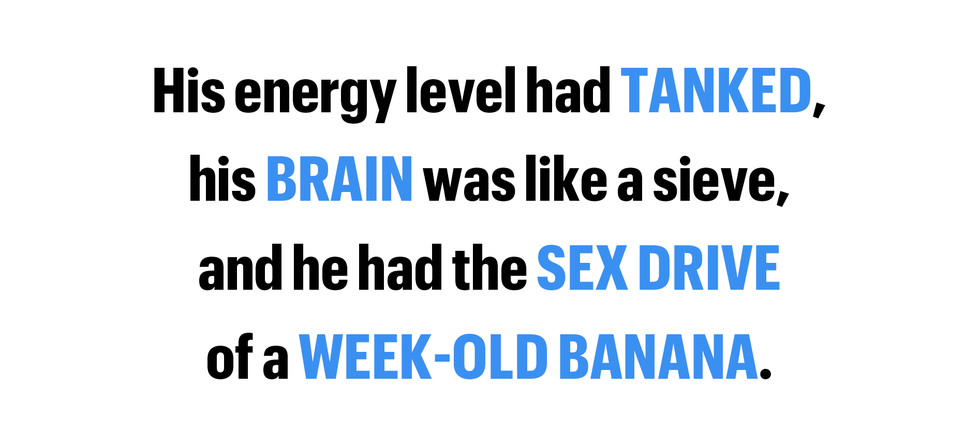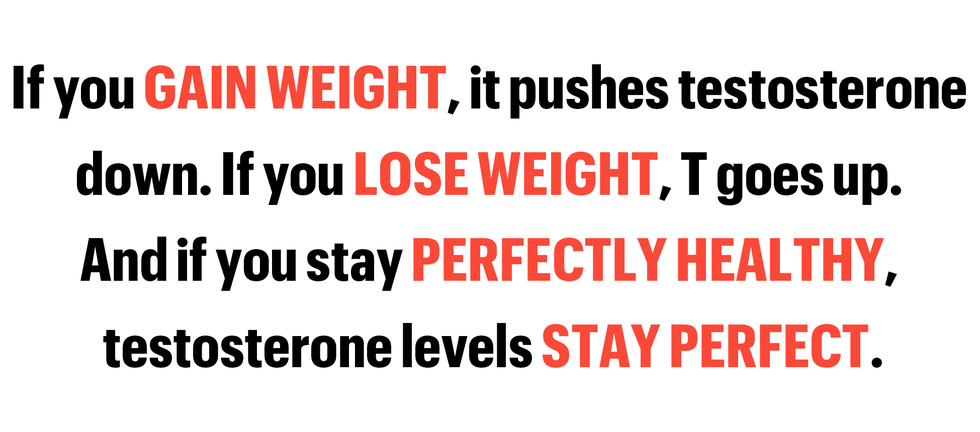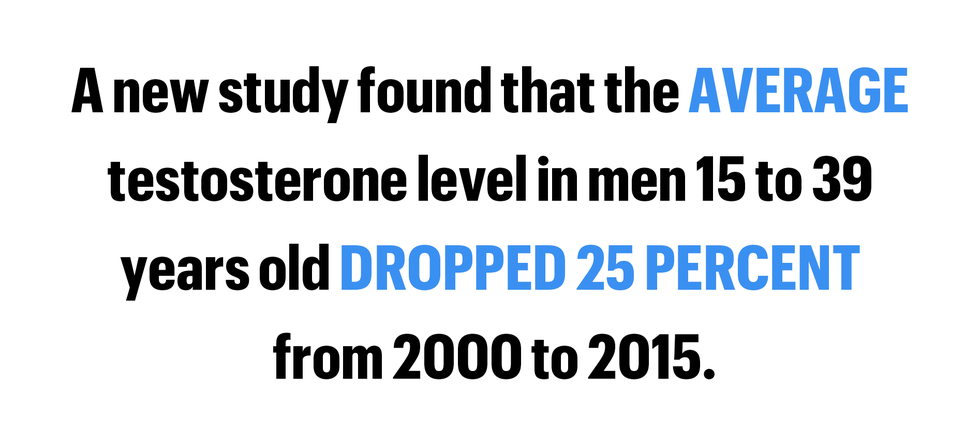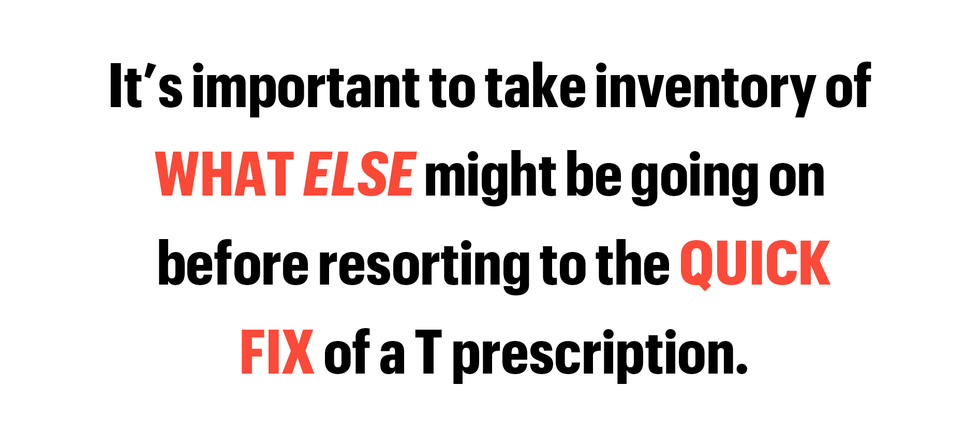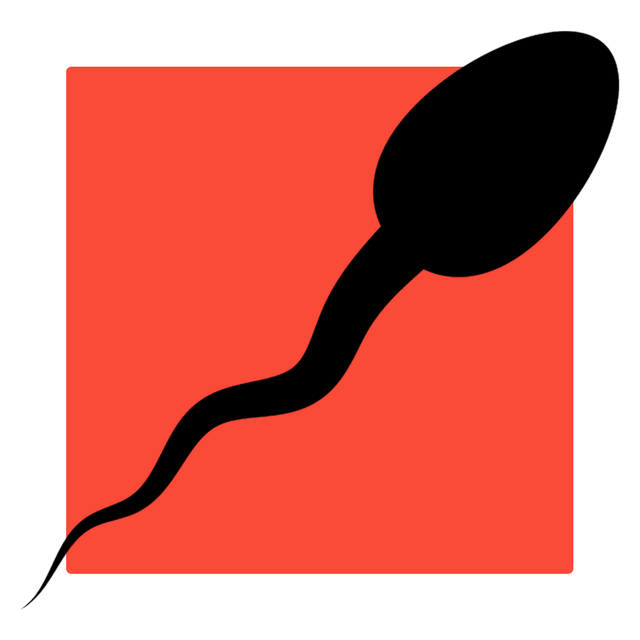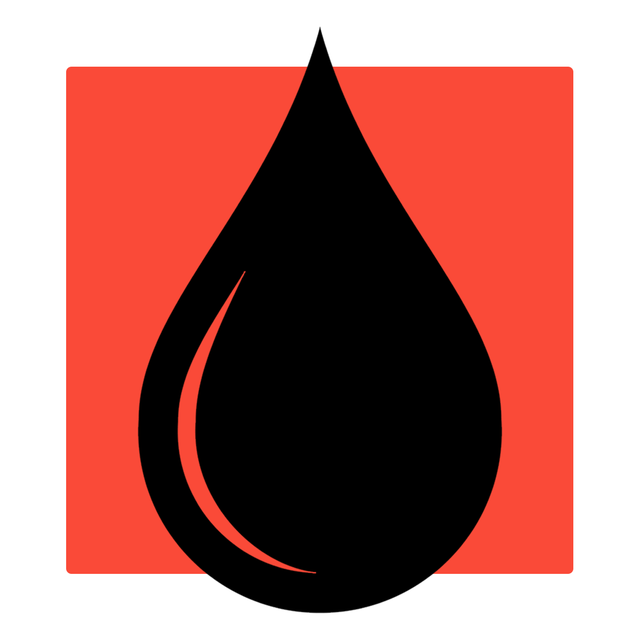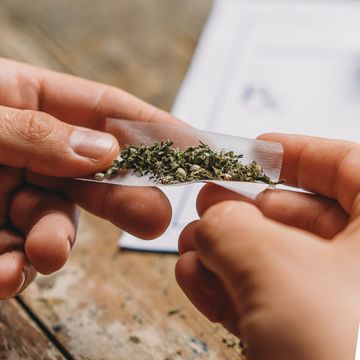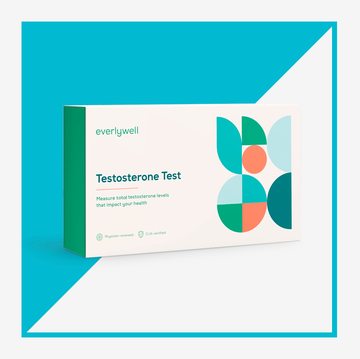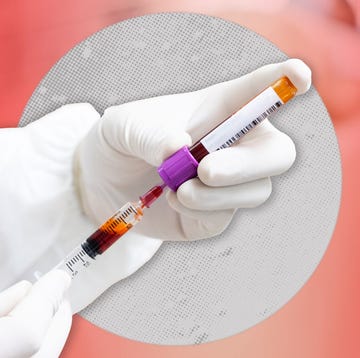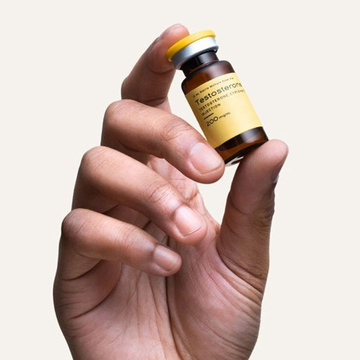SAAD ALAM WAS worried. His doctor had called him into the office to talk about his latest test results. At 35, Alam had been feeling off his game for a while. His energy level had tanked, his brain was like a sieve, and he had the sex drive of a week-old banana. Worse, despite working out religiously, he was growing a set of baby love handles. He’d gone to his doctor to try to figure out what was wrong, and now he was about to find out. Was it cancer? Something worse?
Nope. The diagnosis: Alam was suffering from “existential millennial angst.” Frustrated, he went on to see a dozen more specialists before one finally deduced, via a blood test, that his testosterone level was very low. Endocrinology experts say that a healthy man’s testosterone should range from about 264 to 916 nanograms per deciliter. Alam scored a 187. “The doctor said, ‘You’ve got the testosterone levels of an 80-year-old man,’ ” he recalls.
If the diagnosis was alarming, the fix was relatively simple. The doc prescribed hormone therapy, and within three months, Alam says, he felt like his old self again. But the story does not end there. Four years after he walked out of that first doctor’s office, Alam is the founder and CEO of a telehealth startup called Hone that offers “hormone optimization” to men in the throes of middle age.
Launched in April 2020, the company has a sleek website that promises “More energy. More confidence. More drive. Delivered to your doorstep.” Hone resembles other players in the online men’s health space, such as Roman and Hims, which provide meds for erectile dysfunction and hair loss without the need for awkward conversations with your doctor. But Hone also represents a new phase in the way men view, and use, hormone-
replacement therapy. Once the favored elixir of aging boomers and cheating athletes, testosterone is now being embraced by younger generations, who find its promised benefits enticing, especially because new science reveals there’s also a lower risk of dangerous side effects than previously believed.
“Testosterone is in some ways the most important molecule in the body with regard to health and wellbeing,” says Abraham Morgentaler, M.D., an associate professor of urology at Harvard Medical School who has researched testosterone’s effects for decades. “And it represents the biggest blind spot in all of mainstream medicine.”
Companies like Hone are bringing T out of the world of sketchy hormone clinics and extreme-bodybuilding websites and making it available to stressed-out millennials trying to kill their dad bods. The median age of a man filling a testosterone prescription in the U. S. is 53. The average age of Hone’s nearly 7,000 members is 39—just old enough to feel the pangs of middle age. “The way I look at it,” Alam says, “is I feel like I’m 25 with the experience of a 40-year-old.” But is testosterone really, as Hone’s website claims, “One solution to many of life’s problems”?
MILLENNIAL GUYS are hardly the first generation to wish they had a little more sauce on their McNuggets. In the late 19th century, a brilliant but bonkers French scientist, Charles Brown-Séquard, injected himself with an extract of mashed-up dog and guinea pig balls. Then in his 70s, he reported an immediate surge in energy and strength, as well as a wickedly improved pee stream.
The male sex hormone testosterone was identified in the early 1930s, and decades’ worth of studies have confirmed what we all know: Testosterone helps men (and women) grow and maintain muscle mass, it heightens competitiveness, and, most of all, it makes you want to go out and have sex—a seductive allure.
But the benefits aren’t just physical. “Testosterone signifies masculinity, and masculinity is power in a lot of ways,” says Carole Hooven, Ph.D., an evolutionary biologist at Harvard and author of T: The Story of Testosterone, the Hormone That Dominates and Divides Us. “It’s dominance, it’s powerful, it’s sexy, and who wouldn't want more of that?”
The trouble is, many men see their T level begin to decline to varying degrees after about age 35, slipping slowly as we ease into midlife. It becomes harder to keep (or get) muscle and far easier to accumulate fat, and perhaps as a result, we end up feeling a bit blah in various areas of our lives—like Alam. Officially, he was diagnosed with hypogonadism, which basically means “no balls.” It wasn’t that he lacked testicles; it’s just that they were failing to produce a normal amount of testosterone. #DeezNuts had checked out.
His situation was not unique: With a little digging, Alam discovered that an estimated 20 percent of his fellow under-40 men have a low testosterone level, defined as below 264. More alarming, testosterone levels in younger American men appear to have fallen across the board. A study published in 2020 found that the average testosterone level in men 15 to 39 years old had dropped from 605 in 1999–2000 to 451 in 2015–16—a 25 percent decrease in just 15 years. American men’s sperm counts, which are related to testosterone, have been plummeting for several decades.
Odds are, your own body has been naturally suppressing your T for the past year or two. It’s an evolutionary imperative in times of crisis: Why make babies if the world’s a dumpster fire? Joseph Alukal, M.D., head of NewYork-Presbyterian’s new men’s health program, has been telling patients for years that if the Bronx Zoo tested the T level of any social animal that’s newly confined, underfed, and agitated—even an alpha male—it will have crashed, because the body curbs the sex drive in times of stress. “In the last year, the universe ran this experiment on all of us,” he says.
Covid-related mind-body traumas and weight gain may be accelerating the low-T spiral, particularly for guys in their 40s struggling with other societal stressors, too. “Men are thinking about their changes with age and feeling like they’re losing a bit of their edge, especially in the workplace,” says Peter Gray, Ph.D., a professor of anthropology at the University of Nevada, Las Vegas. “Someone in their 40s might think: I still need to go prove my worth in society. I’m too young to give up. But now I fall asleep early on a Friday night—what’s going on? And is there something that I can take that can help address this?”
Indeed there is: Thanks to the wonders of modern pharma, testosterone is now available in a cornucopia of forms, from creams to gels to patches to pills to shots to dissolvable lozenges—almost everything short of testosterone-infused underwear (check out the options and their pros and cons here). And it’s not hard to get. While mainstream physicians may hew to official prescribing guidelines, pretty much anyone with a computer or smartphone can get some extra T into their system with the right website.
Safety concerns about possible increased risk of prostate cancer and cardiovascular disease, which prompted dire warnings for decades, have faded in the face of more substantial evidence linking low testosterone levels to greater risk for all kinds of bad stuff, up to and including early death. One large study out of Canada found that men who had undergone testosterone-replacement therapy for more than 16 months actually had less chance of prostate cancer, cardiac events, and death than men who’d had it for shorter periods (or not at all).
Doctors are also discovering that the benefits of testosterone—helping men build muscle and lose fat—could help treat other problems. In a recent clinical trial in overweight men with metabolic syndrome (a cluster of symptoms related to metabolic health, including obesity and poor cholesterol), testosterone was found to help prevent them from slipping into diabetes, says study coauthor Gary Wittert, M.D., a professor of medicine at the University of Adelaide in Australia who has studied hormones for decades.
In a 2016 study, researchers conducted a series of clinical trials in a group of 790 older men with very low T levels. Testosterone supplementation was shown to increase bone density and strength, and subjects reported improved sexual function in the first year. They also didn’t exhibit increased cardiovascular risk, although the number of subjects was too low and the study too short to draw any firm conclusions. All in all: some pretty amazing findings.
But that same 2016 study also revealed some of the ways that testosterone falls short in the miracle-drug department: The men on testosterone did not perform significantly better on most tests of physical function; they also did not see much improvement in their mood or cognition—two of the oft-cited benefits of testosterone therapy.
This trial—like most research into testosterone for anti-aging purposes—was done in a population of older men (all over 65) with very low testosterone. Those men benefit in specific ways that might be different from a younger guy’s experience. So where are the studies in younger and middle-aged guys? The 39-year-olds who are signing up for testosterone treatment online? “We’re doing that experiment in the wild right now,” says Carole Hooven of Harvard, “whether we admit it or not.”
Alam saw a way to turn his diagnosis into a business: offer hormone therapy, but in a clean, safe, medically responsible way. A few clicks on Hone’s website and a $45 testosterone test kit will appear on your doorstep. You consult with a physician, then squeeze a few drops of blood onto a card and send it back to be tested for eight different hormones and biomarkers (all related to testosterone), with a follow-up test a couple of weeks later to confirm the results and assess your prostate and cardiovascular health. Then comes another discussion with a doctor to determine whether or not you need hormone therapy and, if so, what kind is best. Alam takes a relatively low dose of 50mg per week split between two injections (or about half the standard dose used in testosterone-replacement therapy). In comparison, competitive bodybuilders might inject between 500 and 2,000mg per week.
All in, a Hone membership costs $120 per month, which covers quarterly monitoring tests and physician consultations, plus about $50 for medications. Other sites, like Roman, Opt, Blokes, and Maximus offer similar services.
With T so easily available—and seemingly safe to use—the question then becomes: Why not take it? Answer: Because you might not even need it.
BESIDES THE FACT that they are about the same age, Ryan Hall, 39, has almost nothing in common with Saad Alam. Whereas Alam is an entrepreneur with a master’s in public health and an M.B.A., Hall is a former world-class runner with multiple top-ten finishes at major marathons, including the 2008 Olympics in Beijing.
But just like Alam, Hall was battling his own extremely low testosterone level. This might seem strange for an elite athlete, but during his career, he regularly tested in the 150 range, well below the lower end of normal for a man in his 30s. Even though he was finishing marathons with the lead pack, he felt terrible. “I felt like a walking dead man, just tired all the time,” he says. “All I did was sleep, eat, and train.”
Anti-doping rules made testosterone therapy off-limits while he was competing, but after he retired in 2016, Hall began looking into it seriously. “I knew I didn’t want to keep living with such low hormone levels,” he says.
Testosterone replacement seemed like an obvious, easy solution. But it became less enticing when Hall discovered that taking extra testosterone has the unfortunate side effect of suppressing a man’s natural testosterone production—and, not incidentally, often shrinking the testicles—as the body senses that it has enough of the hormone already. After a couple of months, testosterone and sperm production shut down completely. Hall found that to be a deal breaker. “I got curious about what was causing my low testosterone,” he says. “Was it physiological, something inside of me? Or was it my lifestyle?”
Bingo: Multiple studies have found that high-volume endurance training, such as serious running and cycling, can depress a man’s testosterone level, sometimes drastically. Hall stopped running almost entirely and began lifting weights daily. He also worked on improving his sleep. As a half-starved endurance athlete, he’d kept himself very light, a skinny 140 pounds on his five-ten frame. So he allowed himself to eat more calories. Between that and the weightlifting, he bulked up to a muscular 185 pounds; in Instagram photos now, he’s almost unrecognizable compared with his marathoning days. And slowly but surely, his testosterone climbed from below 200 up to 600—solidly in the normal range for the first time in his life.
“If you start hormone replacement, you’re in it for the long haul,” he says. “So why not first try to raise it naturally and get it into a good spot?”
ON HIS OWN, Hall had discovered a crucial fact about testosterone, which is that it fluctuates—continually—in response to things that are happening in the body or the environment. These changes can occur over months and years, as they did with him, or in mere seconds. Did an attractive female walk by? Your testosterone probably just went up. Are you competing with another guy for a promotion, or even a parking spot? T boost. Did you win a tennis match against your best frenemy? T boost. Are you fighting a cold or the flu? Your T level is likely going to take a hit. Even the time of day matters: Testosterone is typically highest in the early morning and then declines steadily throughout the day, which is why “evening wood” is not really a thing.
Even as guys look to testosterone to revive their flagging libido, it turns out that sex itself can boost testosterone levels—thinking about it, having it, or even just watching it. In one of the more intrepid hormone studies ever done, two female researchers working with Peter Gray at UNLV ventured into a Las Vegas swingers club armed with salivary testosterone test kits and, hopefully, latex gloves. They found that men who participated in sex acts over the course of the evening experienced an average testosterone boost of 72 percent, while those who merely watched had an average rise of 11 percent. Food for thought.
But on the other hand, if you happen to meet Ms. or Mr. Right and get into a relationship—well, good for you, but your testosterone will likely begin to decline. Should you settle down together and have a child, it will fall even further; studies have found that the more time men spend caring for young children, the lower their testosterone level can drop. It’s evolution’s way of telling you to be a good dad, says Gray. “If you’ve got a six-month-old that you’re tending to, that might not be the time to be seeking another mate or getting in other kinds of competitive encounters.”
It’s probably also time to drop the swingers club membership and, say, join a gym. Studies have shown that taking testosterone can increase muscle size and strength—but other studies have found that strength training itself can boost testosterone levels, as Hall discovered. “It’s kind of a chicken-and-egg thing,” says Dr. Wittert.
The equation is reversed for fat. “If you gain weight, it pushes testosterone down,” Dr. Wittert says. “If you lose weight, it goes up. And if you stay perfectly healthy, testosterone levels stay perfect.” Studies in very healthy older men reveal no age-related decline in testosterone.
Bottom line: Your testosterone level could say more about your general health than it does about your age. Many things can drive down T levels—for example, being forced to attend your sister’s baby shower. Poor sleep and lots of chronic stress can also disrupt testosterone production long-term, adds Peter Attia, M.D., a physician focused on longevity. “Sleep and stress are the primary drivers” of low testosterone, he says. Deep sleep in particular helps recharge the body’s hormonal axis, renewing its supply of good things like testosterone and human growth hormone. “I need a reason before I’m going to treat someone,” says Dr. Attia. “I don’t just treat to the [testosterone] number. And some people with low testosterone levels might not have any symptoms. They feel just fine.”
We’ve talked about Covid stress, but stress in general can knock testosterone down, through the action of the stress hormone cortisol—which is also elevated by poor sleep hygiene. The same goes for depression, which many men are reluctant to address.
Dr. Wittert argues that it’s important to take inventory of what else might be going on before resorting to the quick fix of a T prescription. “It’s not a substitute for eating better; it’s not a substitute for fixing your mood disorder, or finding you have sleep apnea and getting it treated, or addressing your dyslipidemia or your lack of physical activity, or for getting enough sleep,” he says. “It starts and ends with lifestyle.”
Other doctors see testosterone as a potentially useful treatment for these symptoms, even as a short-term jump-start. The average Hone patient, says the company’s medical director, Jim Staheli, D.O., is “a typical young guy who’s married, he has several children, is overweight, he’s stressed out of his gourd because of his job, he isn’t sleeping, he isn’t eating well—and as a result of those complications, his testosterone has plummeted.”
Not surprising. But, Dr. Staheli adds, this guy is not just going to automatically get a vial of testosterone in the mail next week. His treatment will depend on his blood-test results—testosterone is checked twice—and a follow-up consult with a physician who asks questions about all aspects of his life.
“Someone who’s 35 probably isn’t going to want to be on T for the rest of his life,” Dr. Staheli says. Rather, such a patient might start off on a drug called Clomid, which stimulates the body’s own production of testosterone without impairing fertility; this is what Alam’s doctor first prescribed him.
“We like to focus on the Clomid approach first, see if we can get the natural production up, along with lifestyle changes: diet-related, sleeping better, and certainly exercise,” says Dr. Staheli. “And if we can get their testosterone levels up enough that they become asymptomatic, then it’s a win-win.”
Still, it’s definitely worth figuring out why your testosterone is low before clicking “checkout” for that online prescription.
FEELING SLUGGISH, MEH IN BED,
NOT YOURSELF?
Get your T level tested.
You’ve got a bunch of testing options, but a few rules apply to all: Get two tests on two different days to arrive at an average, and aim to get the test in the morning, when your T level is highest. (Levels can fluctuate up to 40 percent during the day.) —Kevin Dupzyk
KNOW THE RISKS OF TAKING T
This story originally appeared in the January/February 2022 issue of Men's Health.

Bill Gifford is the coauthor of Outlive, with Peter Attia, M.D. A longtime contributor to Menʼs Health, he lives in Salt Lake City.

